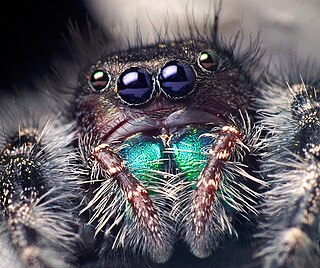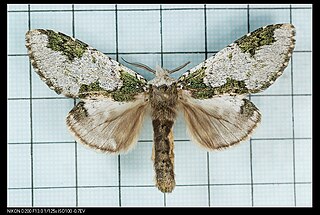
Coprinus is a small genus of mushroom-forming fungi consisting of Coprinus comatus - the shaggy ink cap (British) or shaggy mane (American) - and several of its close relatives. Until 2001, Coprinus was a large genus consisting of all agaric species in which the lamellae autodigested to release their spores. The black ink-like liquid this creates gave these species their common name "ink cap" (British) or "inky cap" (American).

Phidippus is a genus in the family Salticidae. Some of the largest jumping spiders inhabit this genus, and many species are characterized by their brilliant, iridescent green chelicerae. Phidippus is distributed almost exclusively in North America, with the exception of two exported species. As of January 2021, there were about 80 described species in the genus. Species previously described in Phidippus which are found in India and Bangladesh do not belong in this genus.

The Psathyrellaceae are a family of dark-spored agarics that generally have rather soft, fragile fruiting bodies, and are characterized by black, dark brown, rarely reddish, or even pastel-colored spore prints. About 50% of species produce fruiting bodies that dissolve into ink-like ooze when the spores are mature via autodigestion. Prior to phylogenetic research based upon DNA comparisons, most of the species that autodigested were classified as Coprinaceae, which contained all of the inky-cap mushrooms. However, the type species of Coprinus, Coprinus comatus, and a few other species, were found to be more closely related to Agaricaceae. The former genus Coprinus was split between two families, and the name "Coprinaceae" became a synonym of Agaricaceae in its 21st-century phylogenetic redefinition. Note that in the 19th and early 20th centuries the family name Agaricaceae had far broader application, while in the late 20th century it had a narrower application. The family name Psathyrellaceae is based on the former Coprinaceae subfamily name Psathyrelloideae. The type genus Psathyrella consists of species that produce fruiting bodies which do not liquify via autodigestion. Psathyrella remained a polyphyletic genus until it was split into several genera including 3 new ones in 2015. Lacrymaria is another genus that does not autodigest its fruiting bodies. It is characterized by rough basidiospores and lamellar edges that exude beads of clear liquid when in prime condition, hence the Latin reference, lacryma (tears).

Coprinus comatus, the shaggy ink cap, lawyer's wig, or shaggy mane, is a common fungus often seen growing on lawns, along gravel roads and waste areas. The young fruit bodies first appear as white cylinders emerging from the ground, then the bell-shaped caps open out. The caps are white, and covered with scales—this is the origin of the common names of the fungus. The gills beneath the cap are white, then pink, then turn black and secrete a black liquid filled with spores. This mushroom is unusual because it will turn black and dissolve itself in a matter of hours after being picked or depositing spores.

Coprinopsis is a genus of mushrooms in the family Psathyrellaceae. Coprinopsis was split out of the genus Coprinus based on molecular data. The species Coprinopsis cinerea is a model organism for mushroom-forming basidiomycota, and its genome has recently been sequenced completely.

Mopsus mormon is an Australian spider species of the family Salticidae. It is the sole species in the genus Mopsus. It is found in New Guinea and eastern Australia. It is commonly called the green jumping spider.

The white-crowned hornbill, also known as the long-crested hornbill or white-crested hornbill, is a species of hornbill.

Spiders are air-breathing arthropods that have eight legs, chelicerae with fangs generally able to inject venom, and spinnerets that extrude silk. They are the largest order of arachnids and rank seventh in total species diversity among all orders of organisms. Spiders are found worldwide on every continent except for Antarctica, and have become established in nearly every habitat with the exceptions of air and sea colonization. As of July 2019, at least 48,200 spider species, and 120 families have been recorded by taxonomists. However, there has been dissension within the scientific community as to how all these families should be classified, as evidenced by the over 20 different classifications that have been proposed since 1900.
Amblyseius comatus is a species of mite in the family Phytoseiidae.

Syntypistis comatus is a species of moth of the family Notodontidae first described by John Henry Leech in 1898. It is found in China, Taiwan, India, Myanmar, Thailand, Vietnam, Malaysia, Indonesia the Philippines and New Guinea.
Dasypsyllus comatus is a species of flea in the family Ceratophyllidae. It was described by Karl Jordan in 1933.
Pseudangulatus comatus is a species of beetle in the family Cerambycidae, and the only species in the genus Pseudangulatus. It was described by Dillon and Dillon in 1959.
Typhistes antilope, is a species of spider of the genus Typhistes. It is endemic to Sri Lanka.
Typhistes is a genus of sheet weavers that was first described by Eugène Louis Simon in 1894.

Dolichopus comatus is a species of long-legged fly in the family Dolichopodidae.
Phobetus comatus, or Robinson's rain scarab, is a species of scarab beetle in the family Scarabaeidae. It is found in North America.
Pityoborus comatus is a species of typical bark beetle in the family Curculionidae. It is found in North America.
Gerris comatus is a species of water strider in the family Gerridae. It is found in North America.
Phidippus comatus is a species of jumping spider in the family Salticidae. It is found in North America.









